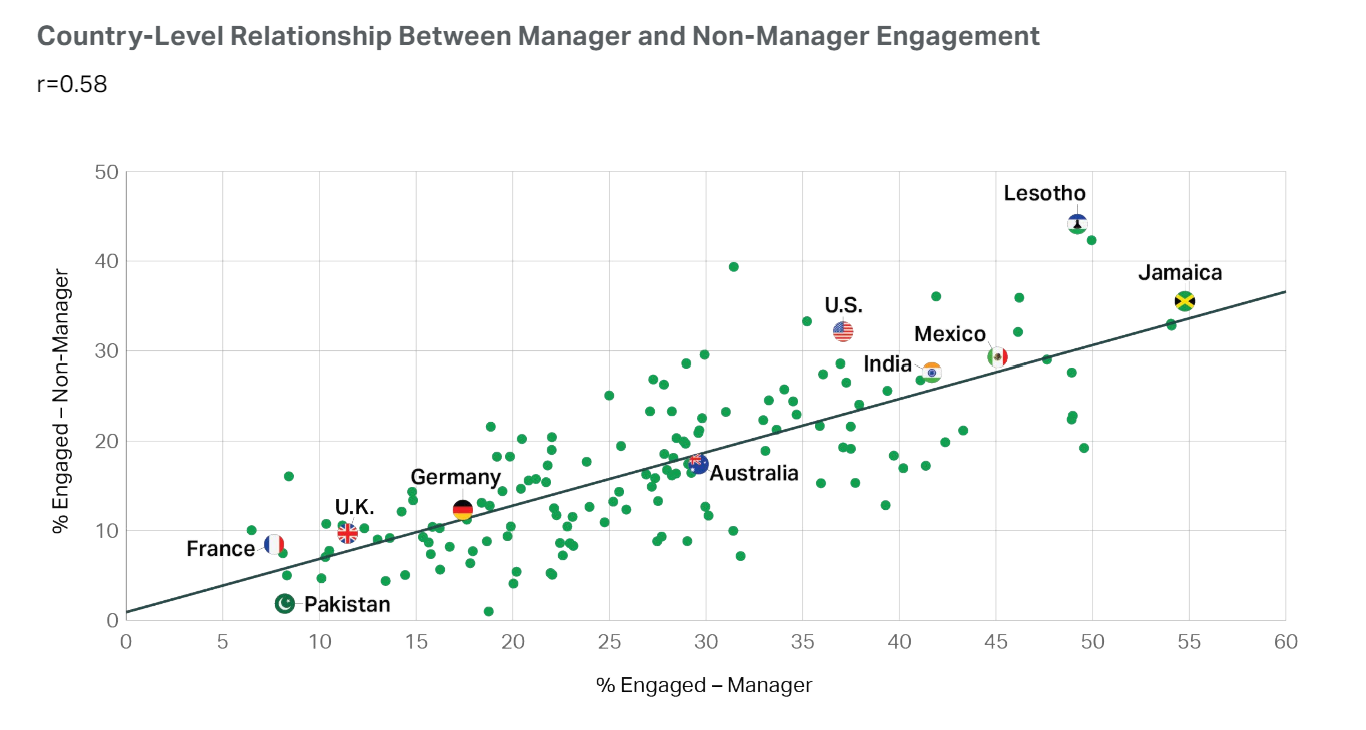We’re always excited to read Gallup’s workplace reports, and their 2024 State of the Global Workforce report is no different!
This report puts the spotlight on the world’s employees – particularly how they feel about their jobs. It’s an eye-opening read, especially around employees’ mental wellbeing and how work affects it – we’re talking stress, anxiety, anger and more.
Low employee engagement costs the global economy an estimated 9% of global GDP.
- Gallup 2024
1. A LOT of employees are stressed

One of the most alarming findings from this year’s report is that 41% of employees report experiencing ‘a lot of stress’ – and unsurprisingly, this figure is almost 60% higher still in badly run companies.
In fact, feelings such as stress, worry and anger are higher among actively disengaged employees than the unemployed, showing the significant impact of work on stress levels.
But few organisations know how to handle workplace stress. If there are any initiatives in place at all, it will often be the offer of a mindfulness or wellbeing app – in other words, treating the symptom, not the root cause. What companies really need is long-term solutions to build workplaces where stress is minimised and all employees have the support they need, when they need it, before things get worse than they need to be.
2. Employee loneliness is more common than you might think
20% of employees globally report daily feelings of loneliness, rising to 25% for fully remote workers. Employees love the flexibility of hybrid and remote work, but many people are struggling to adapt to losing the daily social interaction of the office – particularly extroverts, who thrive in social situations.
But the good news is that face-to-face interaction isn’t the only way to scratch the social itch for these employees. In fact, all forms of ‘social time’ at work, including phone calls, video calls, texts and instant messaging, contribute to better mood and reduced feelings of loneliness.
No matter where your employees work, whether that’s primarily on-site, exclusively remote or a mix of the two, it’s important to offer up plenty of opportunities to connect. Many of us spend more time working than we do with our own families, so the workplace plays a vital role in the move to reduce loneliness.
3.There’s a strong link between manager engagement and employee engagement

Source: Gallup 2024 State of the Global Workforce report
The Gallup report revealed the powerful link between manager and employee engagement, with Jamaica leading the way in manager engagement (and the UK landing near the bottom of the pack for overall engagement).
This is likely to be a trickle-down effect – if an employee’s manager is enthusiastic and positive about their work and the company as a whole, their direct reports are more likely to follow suit. Or, perhaps more understandably, if a manager is obviously disengaged and shows no real interest in their work or team, it stands to reason that their employees won’t feel great about their jobs either.
This could suggest that when you’re focusing on workplace engagement, it might be smart to start with your business leaders and managers. They can act as ambassadors for your engagement efforts, and help get their teams reengaged with their roles for the greater good of the company.
TL;DR? The more engaged your managers, the more engaged your employees. Simple!
4. Managers struggle more at work than non-managers
While managers are a third more likely to say that they are ‘thriving’ in life than other employees, it comes at a cost in terms of their mental health and wellbeing.
In fact, managers rank higher for all five negative feelings measured in the Gallup survey (stress, anger, sadness, loneliness, worry) than for non-managers, with managers ranking five full percentage points higher for anger than their non-manager colleagues. On top of this, 56% of managers are looking to leave their current job, vs 50% of non-managers – more than a 10% increase.
When you’re planning your leadership training, pay particular attention to your accidental managers. These are likely to be people promoted into leadership positions on the basis of their skills in their field, but they may not be equipped with the unique skills needed to be a good manager. Think about what these managers might need, and what skills and behaviours they could learn from your more experienced business leaders, to help keep those negative emotions at bay.
5. Employee engagement is very stable in Europe
The semi-good news is that nothing much has changed in employee engagement in Europe over the last year.
The not-so-good news is that nothing much has changed in employee engagement in Europe over the last year.
Europe has the lowest percentage of engaged employees worldwide, with just 13% of employees in the region saying they’re engaged at work (vs 36% of employees in North America). However, while 49% of those in North America experience daily stress, just 37% say the same in Europe. We’re less stressed than our friends across the pond, but we’re also less engaged. Swings and roundabouts?!
Interestingly, it seems as though Europeans don’t mind feeling disengaged at work, as just 32% of employees are looking to leave their jobs despite 57% saying the current job climate is good. In addition, just 4% of European employees say that they’re suffering in their general lives.
OK, so maybe the European attitude to work isn’t going to break any records, but at least we’re content in our apathy, right?
The takeaways
While global employee engagement may not have significantly improved in the last year, the silver lining is that it hasn't got any worse either.
It's been a tough few years for employees, who have worked (and lived) through a global pandemic, huge political and economic instability and industry-specific challenges, resulting in constant change and confusion for everyone.
Now we're in a period of relative stability, this could be the right time to start nudging employee engagement in the right direction - and that starts with building a good learning culture. With better engagement comes better productivity, employee retention and wellbeing, which can only be a good thing for businesses and employees alike.
